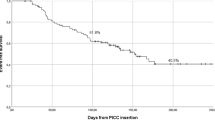Abstract
Patients undergoing autologous peripheral blood stem cell transplantation (PBSC) frequently require the sequential insertion of two central venous catheters, one for leukapheresis and one for transplant support. Hybrid catheters suitable for leukapheresis and long-term use have been increasingly used, but there is limited information regarding their performance and complication rate. The purpose of this study was to determine the performance of the Pheres-Flow hybrid catheter when utilized for both leukapheresis and transplant support, with particular emphasis on the incidence of infectious and occlusive complications. We prospectively analyzed the performance of 92 catheters in 82 consecutive patients who underwent autologous peripheral blood stem cell (PBSC) transplantation. Occlusion was the most frequent complication of this catheter with 29% of the patients experiencing difficulty drawing blood or infusing fluids. Infection was another frequent complication. Twenty-two percent of patients developed catheter-related bloodstream infections and 15 catheters had to be removed because of proven or suspected infection that did not respond to antibiotic therapy. Nevertheless, 77% of patients were able to complete leukapheresis and transplant support with only one catheter. We conclude that the utilization of the Pheres-Flow catheter for both leukapheresis and transplant support is feasible, but that new strategies need to be developed to decrease the incidence of occlusive and infectious complications of hybrid catheters.
Similar content being viewed by others
References
Lazarus HM, Trehan S, Miler R et al. Multi-purpose silastic dual-lumen central venous catheter for both collection and transplantation of hematopoietic progenitor cells Bone Marrow Transplant 2000 25: 779 785
Meisenberg BR, Callaghan M, Sloan C et al. Complications associated with central venous catheters used for the collection of peripheral blood progenitor cells to support high dose chemotherapy and autologous stem cell rescue Support Care Cancer 1997 5: 223 227
Cera SM, Carpenter T, Frenette G, White RL . The Neostar catheter: improved venous access for high dose chemotherapy and pheresis J Clin Oncol 2001 20 (Suppl. 2): 5b (Abstr. 1766)
Pearson ML . Guideline for prevention of intravascular-device-related infections Infect Control Hosp Epidemiol 1996 17: 438 473
Sherertz RJ . Surveillance for infections associated with vascular catheters Infect Control Hosp Epidemiol 1996 17: 746 752
Freytes CO . Indications and complications of intravenous devices for chemotherapy Curr Opin Oncol 2000 12: 303 1307
Eastridge BJ, Lefor AT . Complications of indwelling venous access devices in cancer patients J Clin Oncol 1995 13: 233 238
Freytes CO . Vascular access problems revisited: the Multinational Association of Supportive Care in Cancer (MASCC) experience Support Care Cancer 1998 6: 13 19
Edmond MB, Ober JF, Weinbaum DL et al. Vancomycin-resistant Enterococcus faecium bacteremia: risk factors for infection Clin Infect Dis 1995 20: 1126 1133
Keung YK, Watkins K, Chen SC et al. Increased incidence of central venous catheter-related infections in bone marrow transplant patients Am J Clin Oncol 1995 18: 469 474
Moosa HH, Julian TB, Rosenfeld CS et al. Complications of indwelling central venous catheters in bone marrow transplant recipients Surg Gynecol Obstet 1991 172: 275 279
Howell PB, Walters PE, Donnowitz GR et al. Risk factors for infection of adult patients with cancer who have tunneled central venous catheters Cancer 1995 75: 1367 1375
Early TF, Gregory RT, Wheeler JR et al. Increased infection rate in double-lumen versus single lumen Hickman catheters in cancer patients South Med J 1990 83: 34 36
Haire WD, Lieberman RP, Lund GB et al. Thrombotic complications of silicone rubber catheters during autologous marrow and peripheral stem cell transplantation: prospective comparison of Hickman and Groshong catheters Bone Marrow Transplant 1991 7: 57 59
Conlan MG, Haire WD, Lieberman RP et al. Catheter-related thrombosis in patients with refractory lymphoma undergoing autologous stem cell transplantation Bone Marrow Transplant 1991 7: 235 240
Acknowledgements
We are indebted to Bibi Cates for expert secretarial assistance and the housestaff and nurses of the University of Texas Health Science Center at San Antonio and the Audie L Murphy Memorial Veterans Hospital for excellent patient care.
Author information
Authors and Affiliations
Rights and permissions
About this article
Cite this article
Restrepo, A., Devore, P., Encarnación, C. et al. Performance of a hybrid central venous catheter utilized for both peripheral blood stem cell harvest and transplant support of patients undergoing autologous peripheral blood stem cell transplantation. Bone Marrow Transplant 30, 389–395 (2002). https://doi.org/10.1038/sj.bmt.1703647
Received:
Accepted:
Published:
Issue Date:
DOI: https://doi.org/10.1038/sj.bmt.1703647
- Springer Nature Limited
Keywords
This article is cited by
-
Catheter management across patients with hematologic malignancies and catheter-related blood stream infections: a systematic review
Annals of Hematology (2022)
-
Factors influencing catheter-related infections in the Dutch multicenter study on high-dose chemotherapy followed by peripheral SCT in high-risk breast cancer patients
Bone Marrow Transplantation (2008)
-
Use of totally implantable catheters for peripheral blood stem cell apheresis
Bone Marrow Transplantation (2007)
-
Patterns of use of vascular access devices in patients undergoing hematopoietic stem cell transplantation: results of an international survey
Supportive Care in Cancer (2007)




